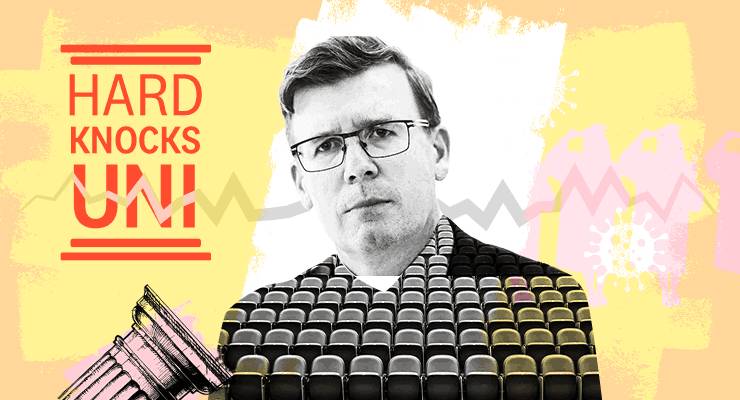
This is part one of the series Hard Knocks Uni: The Crisis in Higher Ed. Read the full series here.
Alan Tudge was optimistic. Addressing the Australian International Education Conference this month, the minister for education and youth believed things were looking better for the beleaguered university sector. Vaccination rates were finally surging. International students would soon start to return.
Many people who weren’t on that zoom call would disagree with Tudge’s rosy picture. Since the pandemic hit, when Scott Morrison told international students to go home and Australia pulled up the drawbridge to the outside world, it has been a bleak time for many in higher education. Some 40,000 jobs are gone, and thousands of lives upended both here and abroad. An entire industry is undergoing an existential crisis.
But Tudge is right to be cheerful. The pandemic might have been a devastating time for academics, casual staff and students, but it’s allowed the Coalition to achieve exactly what it wanted — refashioning the tertiary sector to cut back Commonwealth funding and leave the humanities to whither away.
JobKeeper: the first nail
March 2020 was a profoundly unsettling time, when the pandemic suddenly became real. But universities had long existed in a constant state of precarity. Higher education sits in a liminal space where it is both a multibillion-dollar sector — the source of our fourth largest export market — but with its health hog-tied to the whims of the government.
And governments haven’t been kind. According to the National Tertiary Education Union, government funding over the last decade is about $10 billion less than what was projected in 2010. Both sides of politics bear some responsibility here – the Gillard government cut $2.3 billion from universities in 2013. At the time, Josh Frydenberg called it “unconscionable”.
But for most of that decade, it’s been the Coalition in charge. While university revenue increased over the period, that growth came largely from the fees of domestic and international students, who universities turned to in order to make up for lost government funding. Their numbers grew nearly 60% over the last decade.
So when the border slammed shut, higher education, more exposed to the world than perhaps any sector in Australia, was screwed. Initial modelling suggested a $19 billion revenue shortfall over the next three years. The government’s response was a shrug. Three times the Morrison government changed the rules to exclude public universities from JobKeeper.
The government’s rationale for the exclusion was that universities, backed by the taxpayer, wouldn’t experience a sharp enough revenue fall. Complex funding arrangements made universities an imperfect fit for JobKeeper. But private institutions, including the Australian branch of New York University, weren’t denied the wage subsidy. And Treasury’s recent report, showing the government paid $40 billion to companies that didn’t meet the turnover requirements, makes universities’ exclusion seem all the more harsh. All up, the denial of JobKeeper, and the lack of a substantial rescue package left a bitter taste.
“Universities are not getting a special deal,” Morrison said in July last year.
While JobKeeper might not have been a great fit for universities, the lack of a sufficient funding package for the sector was telling. For Australia Institute economist Eliza Littleton, the decision seemed political.
“Of course we couldn’t predict COVID was going to happen and the border closures were a necessary policy that saved lives. A lot of industries were implicated as a result,” she said.
“But a lot of those industries received quite a bit of support.”
The promise of job-ready graduates
A common attack levelled against the Coalition by political opponents and higher-education wonks is that its approach to universities is ideological.
“The cultural hostility to university education from people who’ve all had a university education is just so stark,” Labor’s shadow education minister Tanya Plibersek said.
Both the past and present shows how ideological that approach has been. Once upon a time there was relative bipartisanship in higher education funding. Then came the Howard government, which shifted the balance of total-education spending from universities to private schools. Its abolition of compulsory student unionism drained millions from student services and organisations while helping accelerate the demise of campus life.
Under the Abbott-Turnbull-Morrison government, higher education funding as a proportion of total education spend fell again. The Abbott government was most nakedly ideological, attempting to deregulate course fees (which would have seen costs balloon) and introduce a 20% funding cut. Twice it failed to pass the Senate. Malcolm Turnbull’s education minister Simon Birmingham introduced a plan to dramatically cut funding while also passing the Senate (“fundamentally fair”, he called it). It too failed.
Where those governments failed, under the guise of the pandemic the Morrison government succeeded. It’s plan unveiled in August last year to save universities was essentially to double the price of arts degrees. The Job-ready Graduates Package, introduced by former education minister Dan Tehan (BA, Melb.) tethered course prices to graduate employment outcomes, shifting students away from impractical communist rubbish like gender studies (and law) and toward useful things like engineering.
Naturally, what drew attention was the apparent attack on the humanities. But beneath the headline it was clear the package also involved a wholesale reduction in government funding to higher education, with student contributions making up the load. It looked like a curious mix of ideology and ineptitude.
“It’s a policy disaster. It doesn’t make sense. It didn’t make sense then, it doesn’t make sense now,” Greens education spokesperson Mehreen Faruqi said.
It was never realistically going to shift students’ subject choice, because thanks to the HECS system, they’re generally not all that responsive to changes in degree cost. Demand for the humanities actually went up this year. If it wanted to reduce public outlay on universities, there were far simpler ways to do that.
“The government introduced a package that doesn’t achieve what it wanted, made the system more complicated, and probably didn’t save money,” University of Melbourne higher education expert Gwilym Croucher said.
And the reform’s great sweetener, the promise to provide funding for an additional 27,000 student places, looks like a furphy according to the University of Melbourne’s Mark Warburton.
“There’s been lots of ideology in it. My analysis of the package is fundamentally they’d been wanting to shift costs to students, and they’ve been successful in doing that,” Warburton said.
Because the government froze university funding for two years in 2017, the package’s promise, to fund more uni places, is actually only enough to cover the un-funded students who grew in numbers during the freeze years. To fund additional places, they’d need to provide an additional $1.1 billion.
Still, for all the policy confusion, the Job-ready Graduates Package achieved that long-held goal of the Coalition to further defund the higher education sector which had been kicking around since Howard: to dramatically reduce the Commonwealth’s spending on universities.
Everything is culture war
Last December, a cabinet reshuffle put Tudge in charge of higher education. The minister wasn’t available for interview for this story. But his recent remarks point to a real optimism about universities that isn’t shared by many in the sector. Tudge points to revenue at major institutions like Monash and Melbourne, which did better than early pessimistic models predicted, as a sign that things really aren’t quite so bad. When asked about ongoing course cuts across universities last week, Tudge denied it.
“No that’s not true.”
As a minister, Tudge is best known for a long series of gaffes. More recently he’s firmed up as one of the most outspoken culture warriors in Morrison’s ministry. His approach to higher education is no different, frequently bashing the universities for not doing enough to protect freedom of speech.
Earlier this year he introduced laws to protect academic freedom. All up, they were a relatively minor tinkering, and a concession the government made to One Nation to get the Job-ready Graduates Package passed. But the consistent focus on a largely confected free-speech crisis on campuses, pushed hard by both Tehan and Tudge, betrays the ideological prism through which the government views the sector.
Universities are a kind of Rorschach test — everyone sees what they want to see. For Liberal MPs, universities are hotbeds of leftism, of cancel culture gone mad, a perspective drilled into them in the hothouse of student politics.
“They still see the world as stupol,” Faruqi says.
But the socialists who made fun of them for being Young Liberals are hardly indicative of the broader student population. Still, that suspicion of universities being their ideological enemies explains everything from the Howard government’s introduction of voluntary student unionism, to Morrison’s unprovoked assault on arts degrees, the lack of a sustained funding package, the obsession with fighting culture war strawmen over shoring up the sector’s future.
In the higher education story, the Liberals are an all-too-easy villain. But they’re not the only ones responsible for the destruction of universities.
Next: Huge salaries, then crying poor. Are universities their own worst enemies?









It is rather hard for me to know just where to begin in responding to this article.
I am not, in any way, shape or form, going to enter this discussion with the aim of suggesting any sort of ‘reform’ or ‘tinkering around the edges’ with education, at any level. What the education sector requires, is what our whole society needs, and this a revolution in approach. To cut a long story short that means a democratic socialist revolution.
To keep on topic, that means that the education sector, from pre-school through to tertiary level, should be publically funded by taxation revenue. Education should be free, secular and compulsory to a certain age level. At the tertiary level I can understand that academic (NOT FINANCIAL) entry standards will need to be reached by potential applicants. But just what those standards should be is another story. However, anyone who can meet those standards should be entitled to a free education.
Educational institutions, at any level, should not be run as businesses. This approach represents nothing more than the perversion and prostitution of a noble and necessary endeavor. Universities should be run by academics for the purpose of educating and NOT for profit.
In Australia, we had a fairer system in place some 50 or more years ago. It was far from perfect but it was better than that which now obtains. So what went wrong? That question is answered very easily. Australian, like so many other western capitalist countries allowed itself to be sold a scam, variously called ‘economic rationalism’ or ‘neo-liberalism’ by some of the world’s greatest confidence tricksters, racketeers and charlatans. It has poisoned just about every aspect of our lives since. We will not even begin to rectify the problems inherent in tertiary education until this curse is removed.
Agree entirely, Richard. I was paid a small bursary some 55years ago, and went through to PhD. My parents could not have afforded to put 5 children through uni on the current system. All 5 have had successful careers that have contributed greatly to society.
Thanks for that Drandy. That is a great outcome.
I agree wholeheartedly- I was at uni with Hockey Taylor etc., feeling so privileged to share the same assets despite my rural state high school background. Now having one child at a state high school and one as a scholarship attendee of a private school- the difference in resourcing is stark- esp in a pandemic. We need to be voting for a better society for our children to be a part of- not a better personal outcome. Labor???
Labor you wonder – just remember that it was the Jack ‘the Artless Dodger‘ Dawkins who first had the wizard idea of HECS though everybody who cared warned that it would quickly become full on fees.
As for education as an ‘export industry‘ – only 3rd World penurious countries export that of which they have don’t have enough for their own population.
Are we having fun yet?
Several things alarm me when it comes to the Liberals’ attitudes and behaviour towards university education.
1. In my professional experience, there is no such thing as a ‘job ready’ graduate. All the professions realise that a young graduate cannot be expected to have any ‘real world’ relevant experience. So the first year or two is a really steep learning curve for young employees. And it is often the ‘soft skills’ that are lacking eg being an effective team member (ie not totally ‘up’ yourself) and acknowledging that you know very little about the ‘reality’.2. I see many young and not so young people with staggering HECS/education debts. Little chance of becoming a home-owner for these folk. 3. Some of those who are aware of the trap mentioned in point 2, choose to ‘not go’ to university.This is a lose / lose scenario. for the individual and for our communities.4. The phobia about ‘science’. 5. The gob-smacking ignorance about current technology, eg. has Michaela C*** updated herself about electric utes? 6. Let’s hope the ‘combined loan book’ of HECS debt doesn’t get sold off to someones ‘mates’. I could go on but I’m depressing myself just thinking about all the damage that has been and is being done.
All valid points but #6 is almost certain if this mob are returned.
Not that Labor would not jump at the chance – look at the shameful sale of War Services Home Loans, sold off to Westpac by the “world’s most gullible Treasure”.
Universities have morphed from tertiary education to a industrial complexes – they have become the Centre Link for the educated unemployed [ and unemployable]. Most courses belong in TAFE educational facilities for the intellectual component of the course and they would be better trained for industry and commerce. Covid is the best thing that has arisen to stop the rot. Real academics have been threatened if they refuse to pass fee paying Chinese students- and the exam papers are passed onto another academic with orders to get a hopeless fee paying student.
Universities tertiary educational facilities – with proper standards should be merit based and free for those that matriculate to the entry standard. They should not be viewed as businesses – which is what the commentariat have said – we have lost $ X billions in export revenue – not one comment about academic work – Universities themselves have only said that – so they should be starved of more funds not given more until they serve the Australian youth and society -not build another business income producing course with no hope of the graduate getting a job .
There’s a lot of truth to that. In practice, university academics are in constant conflict with the managers who run universities over exactly these issues. Most academics want a merit-based, high quality teaching system that educates students. This is clearly different to training for a job. An education should enable a graduate to do any of a range of specialised jobs through giving them high level reasoning and communication skills. Training is for the specifics of a set of tasks.
As to a general fall in educational standards – it begins long before high school, never mind tertiary level.
Have a look at a primary school text book printed before 1960 – in English, arithmetic or geometry etc – and try it on a current high school student.
If the op-shops ever reopen, there are always old Arthur Mee encyclopaedia from the mid 20thC for the taking away.
They have puzzle pages throughout, intended for children up to 10yrs old – mensuration, logic, grammar and comprehension which I suggest would tax most HSC students.
Very sad. This attack on the arts. Without the Arts University’s are just technical institutes. Once again the famous quote comes to mind. “They know the cost of everything and the value of nothing”.
The Sainted Oscar wrote “A fool knows the
costPRICE of everything and the value of nothing” which is more apposite – price being a very mutable thing.If only this lot really did understand the “COST” of their policies, in so many areas.
The pity is that they may actually know but no give a flying as they imagine that it only affects the proles.
Funding had been identified as an issue generations ago due to demographic change, with increasing numbers of retirees/pensioners vs. proportionately fewer working age taxpayers in the permanent population.
Accordingly, in the ’80s international fee paying students, initially they were descendents of Colombo Plan scholarship students from Malaysia, HK, Singapore etc., were actively recruited to supposedly subsidise local students and make up for federal government funding shortfalls.
Fast forward to much growth in international higher education (plus other sectors VET/TAFE and ELICOS/English) compelled by both demand and need for revenue.
The source of the revenue i.e. international students, are often dog whistled or described in pejorative terms as backdoor ‘immigrants’, taking locals’ places etc.. but with Covid the whole wider sector (not just universities) have lost near 100k personnel, many were casual or temporary (nor union members).
However, this does not attract any media attention compared to several hundred blue collar blokes losing their jobs if wearing hard hats and fluro vests……